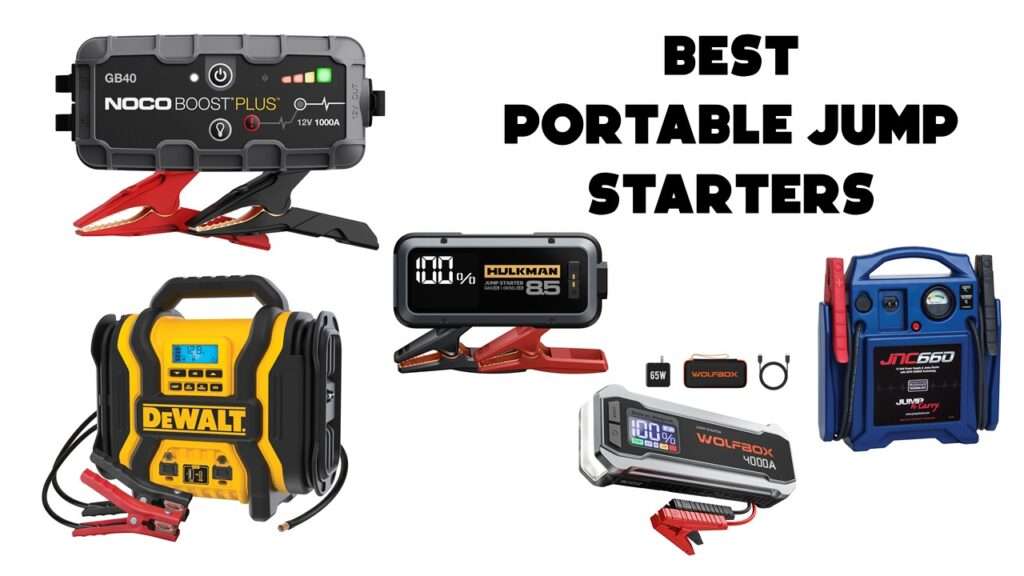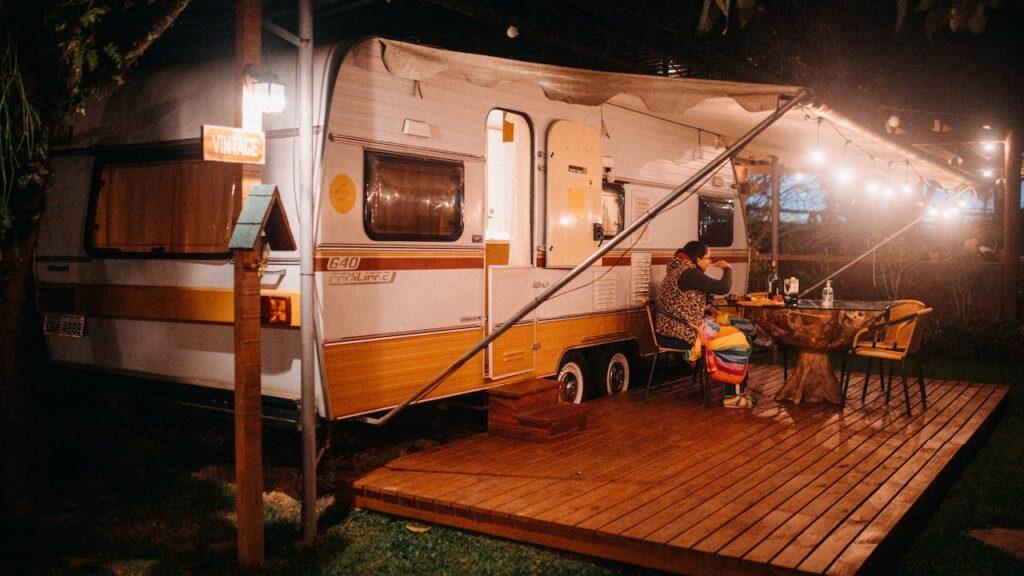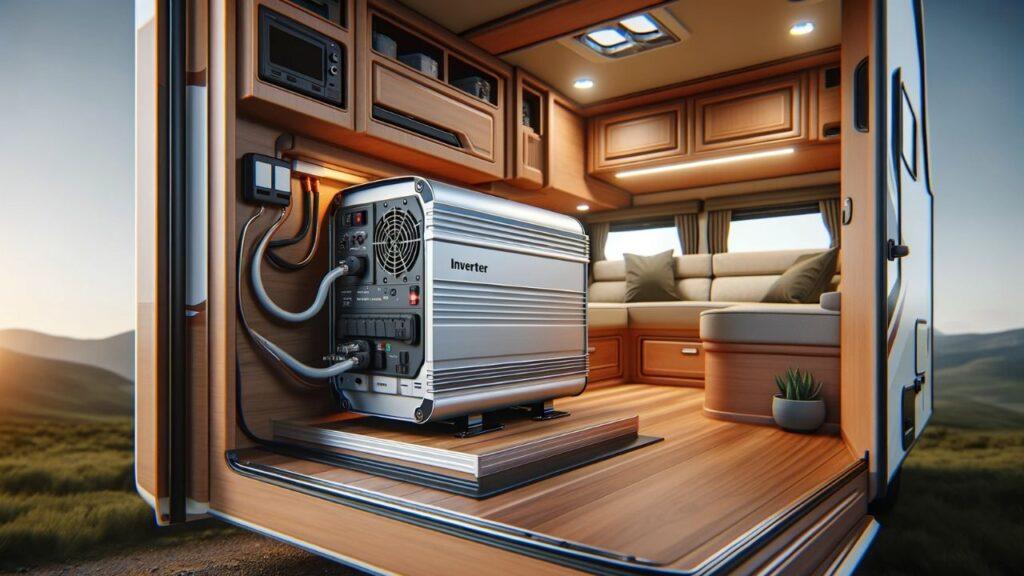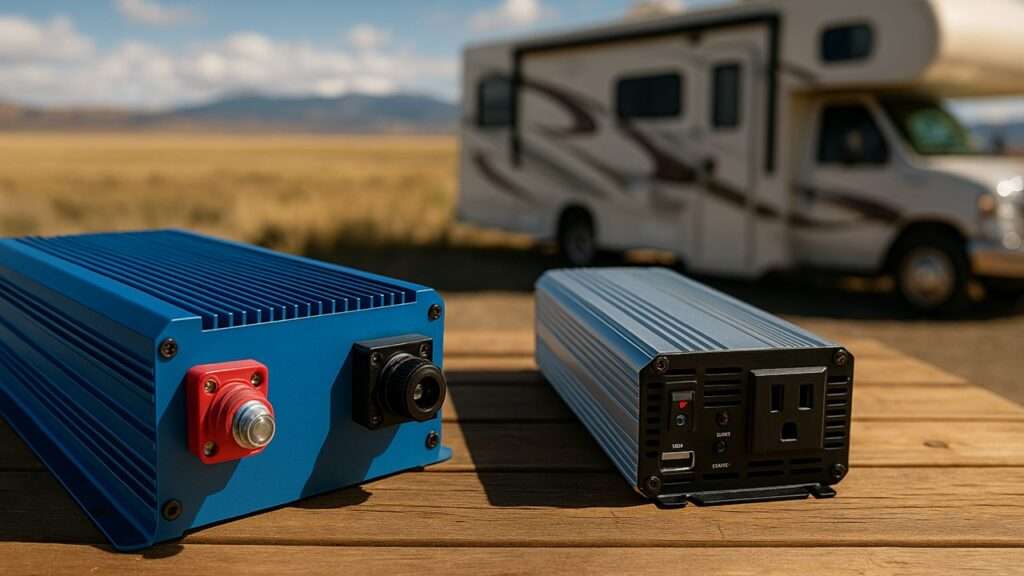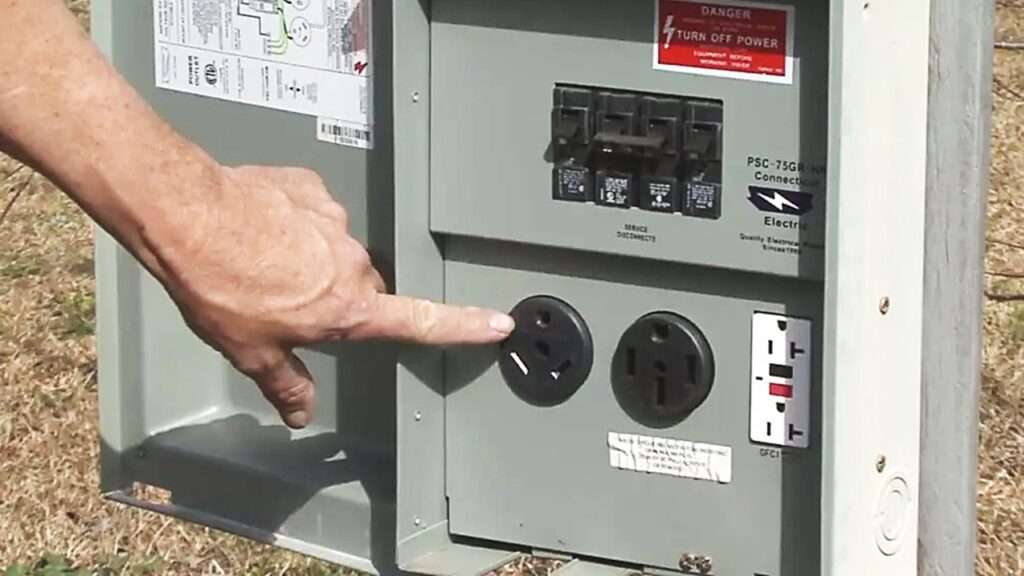
The main difference between a 30-amp and a 50-amp RV system is power capacity. A 30-amp hookup supplies 120 volts at 3,600 watts through a three-prong plug, making it suitable for smaller RVs with basic appliances. A 50-amp hookup delivers up to 12,000 watts at 120/240 volts using a four-prong plug with two hot legs, giving larger RVs enough power to run multiple high-demand appliances like dual air conditioners and washers at the same time.
In this article, we’ll explain how each system works, compare their wiring and capacity, show typical appliance loads, cover adapter and generator use, and help you decide which service fits your RV best.
Key Summary:
- A 30-amp RV system provides 3,600 watts of power, making it suitable for smaller RVs with basic appliances.
- A 50-amp RV system delivers up to 12,000 watts, supporting larger rigs with multiple high-demand appliances.
- A 30-amp plug uses three prongs (1 hot, 1 neutral, 1 ground), while a 50-amp plug uses four prongs (2 hot, 1 neutral, 1 ground).
- A 30-amp RV requires careful load management, while a 50-amp RV allows balanced circuits and greater flexibility.
Disclaimer: We are not licensed electricians or RV technicians. The information in this article is based on online research and general RV owner experiences. Always consult a qualified professional before making any changes to your RV’s electrical system.
Knowing Your RV Electrical System
A 30-amp RV system supplies up to 3,600 watts through a three-prong plug, while a 50-amp RV system delivers up to 12,000 watts through a four-prong plug with two power legs.
The extra capacity in a 50-amp setup allows larger RVs to run multiple high-demand appliances at the same time.
Now let’s break down the basics of RV power so you can understand how these numbers translate to real-world use.
What Is Amperage?
Amperage is the amount of electrical current flowing through your RV’s system. Think of it like water in a hose: more amps mean more flow. A 30-amp RV can handle 30 units of current, while a 50-amp RV can handle up to 50 units on each of its two hot wires. Exceeding that flow trips breakers and cuts off power.
How Voltage and Wattage Work Together
RV hookups in the U.S. use 120 volts of pressure. Multiply that by the available amps, and you get wattage—the actual usable power. A 30-amp RV has 30 × 120 = 3,600 watts available. A 50-amp RV uses two separate 50-amp legs, giving 50 × 120 × 2 = 12,000 watts. Wattage determines how many appliances you can run at once.
Why It Matters for RVers
Understanding amps, volts, and watts helps you avoid electrical overloads, manage appliances wisely, and choose the right surge protectors or adapters. It also ensures you book the correct type of hookup at campgrounds, since plugging a 50-amp rig into a 30-amp site will limit your available power.
What Is a 30-Amp RV Electrical System?
A 30-amp RV electrical system uses a three-prong plug and provides 3,600 watts of power at 120 volts. It is common in smaller to mid-sized RVs and requires careful management of appliances to avoid tripping the breaker.
In practice, a 30-amp system is straightforward. It connects through a three-prong plug consisting of one hot wire, one neutral, and one ground. This setup powers basic appliances like a single air conditioner, microwave, refrigerator, and lights.
Because the capacity is limited to 3,600 watts, you can’t run all heavy appliances at once. For example, turning on the air conditioner and microwave together may push the system close to its maximum. Owners often need to switch devices on and off in rotation to avoid overloads.
This type of system is widely used in smaller trailers, Class B campervans, and many mid-size Class C motorhomes. It keeps things simple and affordable, making it a good match for RVers who don’t need luxury-level power.
What Is a 50-Amp RV Electrical System?
A 50-amp RV electrical system uses a four-prong plug with two hot wires, a neutral, and a ground. It can deliver up to 12,000 watts of power, making it suitable for large RVs with multiple high-demand appliances.
Unlike the 30-amp setup, a 50-amp system provides two separate 120-volt power legs. This split-phase design allows you to balance heavy appliances—like dual air conditioners—across different circuits, so they can run at the same time without overloading.
With 12,000 watts available, 50-amp systems support fridges, electric water heaters, washers and dryers, and entertainment systems. They make large fifth wheels and Class A motorhomes feel more like a house in terms of electrical comfort.
The tradeoff is complexity. A 50-amp power cord is heavier and requires larger hookups, and you’ll often need a surge protector designed specifically for higher amperage. But for anyone traveling in a big rig with multiple amenities, the extra capacity is essential.
Key Differences Between 30-Amp and 50-Amp Systems
The core differences between 30-amp and 50-amp RV systems are power limits, plug design, breaker panel setup, and the size of RVs they support.
A 30-amp hookup provides 3,600 watts with a simpler plug, while a 50-amp hookup can supply 12,000 watts with a more complex four-prong plug.
These differences determine how many appliances you can run and what kind of RV each system fits best.
Power Capacity
The main difference in power capacity is that 30 amps equals 3,600 watts, while 50 amps equals 12,000 watts.
A 30-amp RV system gives you a single stream of 120 volts at 30 amps, which totals 3,600 watts. This is usually enough for one air conditioner, lights, refrigerator, and maybe a microwave, but you have to manage usage carefully.
By contrast, a 50-amp system has two separate 120-volt legs, each capable of 50 amps. Combined, that’s 12,000 watts of available power—more than three times the capacity of a 30-amp hookup.
This massive difference means a 50-amp RV can run multiple air conditioners plus other high-demand appliances like a washer and dryer, electric water heater, or residential refrigerator at the same time.
Plug & Wiring Design
The key difference in plug design is that 30-amp systems use three prongs, while 50-amp systems use four prongs.
- 30-amp RV plug: One hot wire carries all the power, while the neutral returns current and the ground adds safety.
- 50-amp RV plug: Two hot wires each supply 50 amps of power, with a neutral return and a ground.
This wiring difference doubles the usable amperage in a 50-amp system. The four-prong plug is larger and heavier but allows split-phase power distribution, which is why it can support much more wattage.
Breaker Panel Setup
The main difference in breaker panels is that 30-amp RVs have a single panel, while 50-amp RVs use a split panel.
In a 30-amp RV, every circuit runs off the same hot wire, meaning all loads share the same 3,600-watt limit. Once you exceed that limit, the breaker trips and shuts down power.
A 50-amp RV distributes circuits across two hot legs, which allows heavy appliances to be separated onto different circuits.
This not only reduces the chance of overload but also makes it easier to run multiple appliances without interruption.
RV Size & Compatibility
The most practical difference comes down to RV size and what each system is designed to support.
- 30-amp systems: Found in smaller travel trailers, campervans, and many mid-size Class C RVs. They’re ideal for RVers with lighter power needs or who mainly camp in mild weather with minimal appliance use.
- 50-amp systems: Standard in large Class A motorhomes, luxury fifth wheels, and toy haulers. These rigs are built with multiple air conditioners, residential-style refrigerators, washers, and dryers—appliances that require higher power capacity.
For most RV owners, the system is determined at purchase. Upgrading later is possible but expensive and usually unnecessary unless you add heavy appliances.
Comparison Table: 30-Amp vs 50-Amp Systems
| Feature | 30-Amp RV System | 50-Amp RV System |
| Maximum Power | 3,600 watts (30A × 120V) | 12,000 watts (50A × 120V × 2) |
| Plug Type | 3-prong: 1 hot, 1 neutral, 1 ground | 4-prong: 2 hot, 1 neutral, 1 ground |
| Breaker Panel | Single row, one hot leg | Split panel, dual hot legs for load balancing |
| Typical RV Size | Small to mid-size travel trailers, Class B/C | Large fifth wheels, Class A motorhomes |
| Appliances Supported | One AC + basic appliances | Multiple ACs + washer/dryer + large fridge |
Average Amp Draw of Common RV Appliances
The biggest reason to understand 30 vs 50 amps is how much power appliances actually consume. Even small items add up quickly, and in a 30-amp RV, you can overload the system with just two or three devices.
Here are typical draws for popular RV appliances:
- Air conditioner: 12–15 amps
- Microwave: 8–12 amps
- Electric water heater: 10–12 amps
- Refrigerator: 3–5 amps
- Coffee maker or toaster: 8–10 amps
- Television and electronics: 1–3 amps
On a 30-amp system, running one air conditioner (15A) and a microwave (10A) already uses about 25 amps, leaving very little margin for other devices. A 50-amp system spreads loads across two circuits, meaning you can run multiple heavy appliances at once without worrying about tripping breakers.
Using Adapters Between 30A and 50A
Adapters, also called dogbones, make it possible to connect a 30-amp RV to a 50-amp pedestal or a 50-amp RV to a 30-amp hookup. The important thing to know is that adapters don’t increase your RV’s capacity—they only make the connection possible.
30-Amp RV on a 50-Amp Pedestal
When plugged in with an adapter, a 30-amp RV still only draws 30 amps, no matter how much power the pedestal provides. This setup is safe and commonly used, but you won’t gain extra wattage.
50-Amp RV on a 30-Amp Pedestal
When a 50-amp RV is plugged into a 30-amp pedestal, it is limited to 30 amps total. This can be restrictive, as you may only be able to run one air conditioner plus a few small devices. Load management becomes critical—turning off appliances like the water heater or microwave when using the AC.
Safety Considerations
Adapters are safe if used properly, but there are a few rules to follow:
- Always use heavy-duty RV-rated adapters.
- Avoid chaining multiple adapters together.
- Pair the adapter with a surge protector to guard against voltage spikes.
- Watch your total power usage to prevent overheating cords or tripping breakers.
Generators and Off-Grid Use
The main difference when running a generator off-grid is that 30-amp RVs typically need 3,600–4,000 watts, while 50-amp RVs require up to 12,000 watts for full power. Smaller generators can still work with either system, but you’ll have to carefully manage which appliances are running.
Generator Sizing for 30-Amp RVs
A single 30-amp RV usually pairs well with a portable generator rated at 3,600–4,000 watts. This is enough to run an air conditioner plus some smaller devices. If you try to add a microwave or electric water heater at the same time, you may max out the generator’s capacity.
Generator Sizing for 50-Amp RVs
To unlock the full capacity of a 50-amp system, you would need a generator rated around 12,000 watts. In practice, most RVers use smaller units—5,500 to 7,500 watts is common—because they only need to power one or two AC units and some essentials when boondocking.
Load Management While Boondocking
Regardless of size, running an RV on generator power means paying attention to what’s switched on. Staggering heavy appliances, using LED lighting, and relying on propane for water heating or refrigeration can extend runtime and reduce strain on the system.
Surge Protectors and Safety Equipment
Both 30-amp and 50-amp RVs should use a surge protector to guard against power spikes, faulty campground wiring, or brownouts. These devices act like a shield, preventing electrical damage to your RV’s appliances and wiring.
Key points to know:
- Match the protector to your service: Use a 30-amp protector for 30-amp RVs and a 50-amp protector for 50-amp rigs.
- Prevent voltage spikes: Stops lightning strikes or campground surges from frying electronics.
- Protect against miswired pedestals: Detects open grounds, reversed polarity, or faulty breakers before power reaches your RV.
- Avoid expensive repairs: A good protector costs far less than replacing an air conditioner or refrigerator.
Adding this single piece of equipment dramatically increases the safety and lifespan of your RV’s electrical system.
Can You Convert a 30-Amp RV to 50-Amp?
It is possible to convert a 30-amp RV to 50-amp service, but it requires significant rewiring and is rarely worth the cost unless you’re upgrading appliances. The conversion involves replacing the power cord, breaker panel, and adding circuits designed to handle higher loads.
What Conversion Involves
A true conversion isn’t just swapping cords. An electrician must:
- Install a 50-amp power inlet and cord.
- Replace the breaker panel with a split-phase system.
- Rewire circuits to spread loads across two hot legs.
- Add or upgrade outlets for heavy appliances.
When It Makes Sense
This upgrade is only practical if you plan to add multiple air conditioners, a washer and dryer, or other heavy-duty appliances. For smaller rigs, it’s more cost-effective to manage loads within a 30-amp system or use supplemental generators or solar.
Which One Should You Choose?
Choosing between 30-amp and 50-amp comes down to your RV size and lifestyle. A 30-amp system is ideal for smaller rigs with modest electrical needs, keeping things simple and affordable.
A 50-amp system is best for large RVs or anyone wanting to run multiple high-power appliances at the same time.
Matching your RV’s electrical service to your travel style ensures you stay comfortable without overloading your system.
Final Thoughts
Choosing between a 30-amp and a 50-amp RV system ultimately comes down to how much power you need and the type of RV you own. A 30-amp setup provides 3,600 watts, enough for smaller rigs with one air conditioner and basic appliances. It keeps things simple but requires careful energy management.
A 50-amp system, on the other hand, supplies up to 12,000 watts across two power legs. This capacity allows large RVs to run multiple high-demand appliances like dual air conditioners, washers, and dryers without overload issues. The heavier plug and breaker panel design give more flexibility and convenience for extended stays.
Whichever system you have, using adapters, surge protectors, and properly sized generators ensures you can camp safely and comfortably. Matching your RV’s electrical system to your travel lifestyle is the best way to prevent power headaches on the road.
Related FAQs
Is 50-Amp Service Always Better?
Not always. A 50-amp system offers more power but is only necessary for large RVs. Smaller rigs run fine on 30 amps.
Can I Plug a 50-Amp RV Into a 30-Amp Outlet?
Yes, with an adapter, but your RV will be limited to 30 amps total. You’ll need to manage appliances carefully.
Why Do Some Parks Say “100-Amp Service”?
It refers to a pedestal that provides 50A, 30A, and 20A outlets combined, not a single 100-amp connection.
Do I Need a Special Generator for a 50-Amp RV?
Yes, to fully power a 50-amp rig you’d need around 12,000 watts, but many RVers use smaller generators and just limit appliance use.

Jack Rivers is a long-time RVer, a husband, and a dad who’s traveled solo and now with his family. He’s learned a lot from years on the road, sometimes the hard way. From quiet mornings parked by the woods to messy evenings with the kids and a busted heater, he’s been through it all. Miles writes to share the real stuff, the small wins, and the lessons that make RV life worth it, no matter who you’re traveling with.
